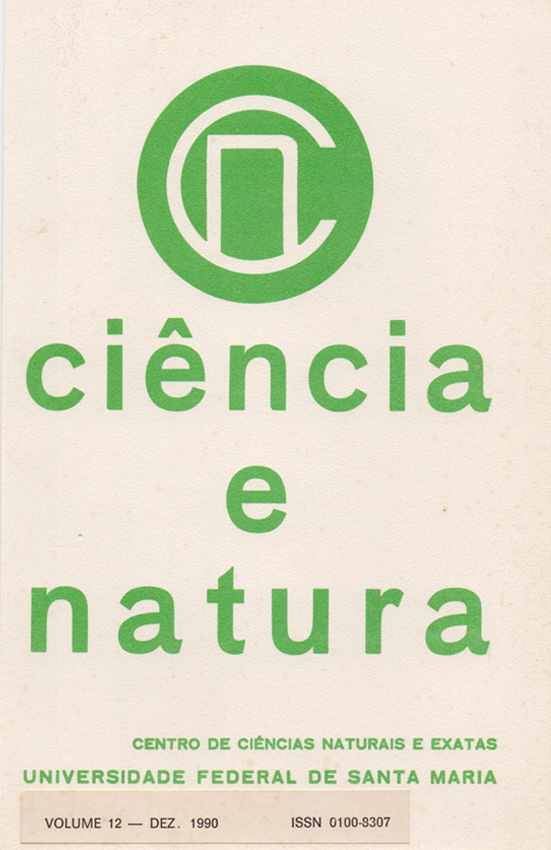Desenvolvimento e mudanças celulares na estrutura dos raios xilemáticos de Rollinia emarginata Schlecht. (Annonaceae)
DOI:
https://doi.org/10.5902/2179460X25496Resumo
Foram observados, a partir de secções longitudinais tangenciais em série do câmbio à medula, o desenvolvimento e as mais significantes mudanças celulares na estrutura dos raios de Rollinia emarginata Schlecht. (Annonaceae). As caracteristicas dos raios das camadas mais externas do xilema secundário são descritas e as principais mudanças na sua estrutura nos diferentes estágios do desenvolvimento secundário são consideradas. As mudanças celulares observadas são extremamente variáveis, ocorrendo isoladamente ou em complexas combinações. As mudanças celulares mais significantes observadas durante o desenvolvimento dos raios são as seguintes: origem de iniciais radiais a partir de iniciais fusiformes ou de iniciais radiais do câmbio; mudanças resultantes do crescimento intrusivo das iniciais fusiformes atravésde um grupo de iniciais radicais e a perda de iniciais radicais do câmbio. Em base desta transformações celulares são consideradas as mudanças mais importantes na origem dos raios secundários, aumento e largura e redução na altura dos raios multisseriados.
Downloads
Referências
Bannan, M.W. Origin and cellular character of xylem rays in gymnosperms. Bot. Gaz, 96:260-81, 1934.
Bannan, M.W. Vascular rays and adventitious root formation in Thuja occidentalis L. Am. J. Botany 28: 457-63, 1941.
Bannan, M.W. The frequency of anticlinal divisions in fusiform cambial cells of Chamaecyparis. Am. J. Botany, 37:511-19, 1950.
Barghoorn, Jr., E.S. Origin and development of theuniseriate rays in the Coniferae. Bulletin of the Torrey Club, 67:303-28, 1940a.
Barghoorn, Jr. E.S. The ontogenetic development and phylogenetic specialization of rays in the xylem of Dicotyledons. I. The primitive ray structure. Amer. J. Botany, 27:918-28, 1940b.
Barghoorn, Jr. E.S. The ontogenetic development and phylogenetic specialization of the rays in the xylem of Dicotyledons. II. Modification on the multiseriate and uniseriate rays. Amer. J. Botany, 28:273-82, 1941a.
Barghoorn, Jr. E.S. The ontogenetic development and phylogenetic specialization of rays in the xylem of Dicotyledons. III. The elimination of rays. Bull. Torrey Bot. Club, 68:317-25, 1941b.
Chattaway, M.M. The wood anatomy of the Family Sterculianeae. Phil. Trans. Roy. Soc., 228:313-65, 1937.
Chadle, V. I. & Esau, K. Secondary phloem of Liriodendron tulipifera. Uni. Calif. Publ. Bot. 36:143-252. 1964.
Comission Panamericana de Normas Tecnicas. 30: 1-019, novembro, 1973.
Cumbie, B.G. Developmental changes in the vascular cambium of the Polygonum lapathifolium. Amer. J. Bot., 56: 139-46, 1969a.
Cumbie, B.G. Developmental changes in the xylem and vascular cambium of Apocynum sibiricum. Bull. Torrey Botanica Club, 96 (6): 629-40, 1969b.
Cumbie, B.G. Developmental changes in the wood of Bocconia vulcanica Donn. Smith. IAWA Bull., n.s. vol.4 (2-3):13140,1983.
Esau, K. Plant Anatomy. New York, John Wiley & Sons. 1965, 767p.
Evert, R.F. Some aspects of cambial development in Pyrus comunis, Am.,J. Bot., 48: 479-88, 1961.
Freund, H. Handbuch der Mikroskopie in der Technik. Frankfurt, Umschan Verlag. 1970, v.5, pt. 2, 379 p.
IAWA Committee on Nomenclature. Multilingual glossary of terms used in wood anatomy. Konkordia, Winterthur. 1964. 186 p.
Johansen, D.A. Plant Microtechnique. McGraw-Hill, New York, 1940, 523 p.
Krigs, D.A. Salient lines of structural specialization in the wood rays of Dicotyledons. Bot. Gaz., 96:547-57, 1935.
Metcalfe, C.R. & Chalk, L. Anatomy of Dicotyledons, Oxford, Claredon Press, Vol. 1,1972,724 p.
Philipson, W.R.; Ward, J.M. & Butterfield, B.G. The vascular com bium. Chapman & Hall Ltd., London, 1971, 181 p.
Wyk, R. W. van der & Canright, J. E. The anatomy and relationships of the Annonaceae. Tropical Woods, 104:1-24, 1956.
Zimmermann, M.H. & Brown, C.L. Trees: structure and function. Springer-Verlag, New York, 1977, 336 p.
Downloads
Publicado
Como Citar
Edição
Seção
Licença
Para acessar a DECLARAÇÃO DE ORIGINALIDADE E EXCLUSIVIDADE E CESSÃO DE DIREITOS AUTORAIS clique aqui.
Diretrizes Éticas para Publicação de Revistas
A revista Ciência e Natura está empenhada em garantir a ética na publicação e na qualidade dos artigos.
A conformidade com padrões de comportamento ético é, portanto, esperada de todas as partes envolvidas: Autores, Editores e Revisores.
Em particular,
Autores: Os Autores devem apresentar uma discussão objetiva sobre a importância do trabalho de pesquisa, bem como detalhes e referências suficientes para permitir que outros reproduzam as experiências. Declarações fraudulentas ou intencionalmente incorretas constituem comportamento antiético e são inaceitáveis. Artigos de Revisão também devem ser objetivos, abrangentes e relatos precisos do estado da arte. Os Autores devem assegurar que seu trabalho é uma obra totalmente original, e se o trabalho e / ou palavras de outros têm sido utilizadas, isso tem sido devidamente reconhecido. O plágio em todas as suas formas constitui um comportamento publicitário não ético e é inaceitável. Submeter o mesmo manuscrito a mais de um jornal simultaneamente constitui um comportamento publicitário não ético e é inaceitável. Os Autores não devem submeter artigos que descrevam essencialmente a mesma pesquisa a mais de uma revista. O Autor correspondente deve garantir que haja um consenso total de todos os Co-autores na aprovação da versão final do artigo e sua submissão para publicação.
Editores: Os Editores devem avaliar manuscritos exclusivamente com base no seu mérito acadêmico. Um Editor não deve usar informações não publicadas na própria pesquisa do Editor sem o consentimento expresso por escrito do Autor. Os Editores devem tomar medidas de resposta razoável quando tiverem sido apresentadas queixas éticas relativas a um manuscrito submetido ou publicado.
Revisores: Todos os manuscritos recebidos para revisão devem ser tratados como documentos confidenciais. As informações ou ideias privilegiadas obtidas através da análise por pares devem ser mantidas confidenciais e não utilizadas para vantagens pessoais. As revisões devem ser conduzidas objetivamente e as observações devem ser formuladas claramente com argumentos de apoio, de modo que os Autores possam usá-los para melhorar o artigo. Qualquer Revisor selecionado que se sinta desqualificado para rever a pesquisa relatada em um manuscrito ou sabe que sua rápida revisão será impossível deve notificar o Editor e desculpar-se do processo de revisão. Os Revisores não devem considerar manuscritos nos quais tenham conflitos de interesse resultantes de relacionamentos ou conexões competitivas, colaborativas ou outras conexões com qualquer dos autores, empresas ou instituições conectadas aos documentos.






